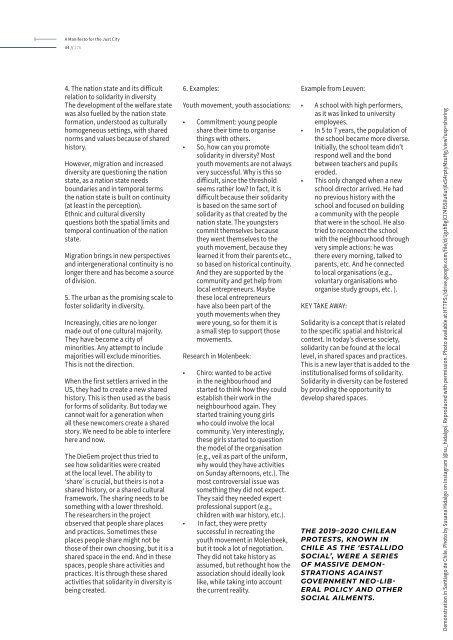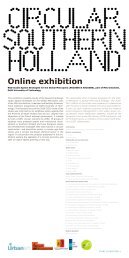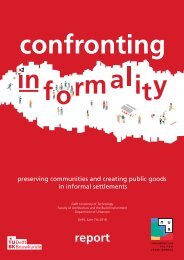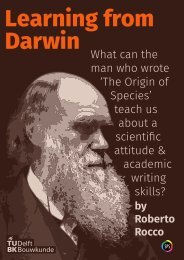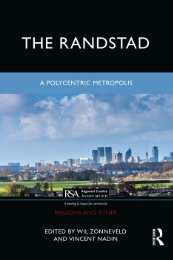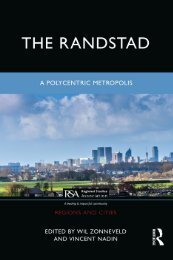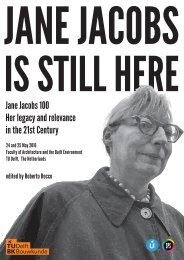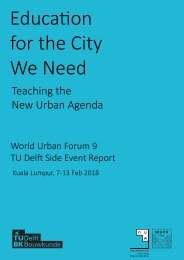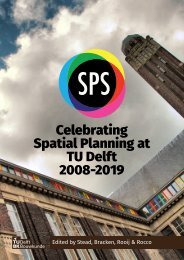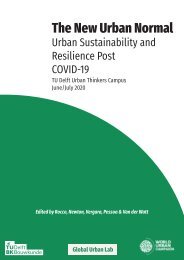A Manifesto for the Just City
On Monday 29 MARCH at 18:00 (CET/Amsterdam), TU Delft launched the Book "A Manifesto for the Just City", with texts by a number of guests and 43 manifestos written by students from 25 universities from all over the world. A “Manifesto for the Just City” comes in the wake of the realisation that socio-spatial justice is a crucial dimension for sustainability transitions. Growing inequality and the erosion of the public sphere undermine the social and political structures required to fight climate change, pandemics and other systemic shocks. With this book, we have sought to encourage students to formulate their own visions for the Just City and for a just transition. This book is result of an Urban Thinkers Campus organised between 9 and 30 November 2020. The Urban Thinkers Campus (UTC) model is an initiative of UN-Habitat’s World Urban Campaign, conceived in 2014 as an open space for critical exchange between stakeholders and partners. It aims to promote debate and action on sustainable and inclusive urbanization upholding the principles and guidelines contained in the New Urban Agenda, launched at Habitat-III in 2016 in Quito, Ecuador.
On Monday 29 MARCH at 18:00 (CET/Amsterdam), TU Delft launched the Book "A Manifesto for the Just City", with texts by a number of guests and 43 manifestos written by students from 25 universities from all over the world.
A “Manifesto for the Just City” comes in the wake of the realisation that socio-spatial justice is a crucial dimension for sustainability transitions. Growing inequality and the erosion of the public sphere undermine the social and political structures required to fight climate change, pandemics and other systemic shocks. With this book, we have sought to encourage students to formulate their own visions for the Just City and for a just transition.
This book is result of an Urban Thinkers Campus organised between 9 and 30 November 2020. The Urban Thinkers Campus (UTC) model is an initiative of UN-Habitat’s World Urban Campaign, conceived in 2014 as an open space for critical exchange between stakeholders and partners. It aims to promote debate and action on sustainable and inclusive urbanization upholding the principles and guidelines contained in the New Urban Agenda, launched at Habitat-III in 2016 in Quito, Ecuador.
Create successful ePaper yourself
Turn your PDF publications into a flip-book with our unique Google optimized e-Paper software.
A <strong>Manifesto</strong> <strong>for</strong> <strong>the</strong> <strong>Just</strong> <strong>City</strong><br />
44 // 276<br />
4. The nation state and its difficult<br />
relation to solidarity in diversity<br />
The development of <strong>the</strong> welfare state<br />
was also fuelled by <strong>the</strong> nation state<br />
<strong>for</strong>mation, understood as culturally<br />
homogeneous settings, with shared<br />
norms and values because of shared<br />
history.<br />
However, migration and increased<br />
diversity are questioning <strong>the</strong> nation<br />
state, as a nation state needs<br />
boundaries and in temporal terms<br />
<strong>the</strong> nation state is built on continuity<br />
(at least in <strong>the</strong> perception).<br />
Ethnic and cultural diversity<br />
questions both <strong>the</strong> spatial limits and<br />
temporal continuation of <strong>the</strong> nation<br />
state.<br />
Migration brings in new perspectives<br />
and intergenerational continuity is no<br />
longer <strong>the</strong>re and has become a source<br />
of division.<br />
5. The urban as <strong>the</strong> promising scale to<br />
foster solidarity in diversity.<br />
Increasingly, cities are no longer<br />
made out of one cultural majority.<br />
They have become a city of<br />
minorities. Any attempt to include<br />
majorities will exclude minorities.<br />
This is not <strong>the</strong> direction.<br />
When <strong>the</strong> first settlers arrived in <strong>the</strong><br />
US, <strong>the</strong>y had to create a new shared<br />
history. This is <strong>the</strong>n used as <strong>the</strong> basis<br />
<strong>for</strong> <strong>for</strong>ms of solidarity. But today we<br />
cannot wait <strong>for</strong> a generation when<br />
all <strong>the</strong>se newcomers create a shared<br />
story. We need to be able to interfere<br />
here and now.<br />
The DieGem project thus tried to<br />
see how solidarities were created<br />
at <strong>the</strong> local level. The ability to<br />
‘share’ is crucial, but <strong>the</strong>irs is not a<br />
shared history, or a shared cultural<br />
framework. The sharing needs to be<br />
something with a lower threshold.<br />
The researchers in <strong>the</strong> project<br />
observed that people share places<br />
and practices. Sometimes <strong>the</strong>se<br />
places people share might not be<br />
those of <strong>the</strong>ir own choosing, but it is a<br />
shared space in <strong>the</strong> end. And in <strong>the</strong>se<br />
spaces, people share activities and<br />
practices. It is through <strong>the</strong>se shared<br />
activities that solidarity in diversity is<br />
being created.<br />
6. Examples:<br />
Youth movement, youth associations:<br />
• Commitment: young people<br />
share <strong>the</strong>ir time to organise<br />
things with o<strong>the</strong>rs.<br />
• So, how can you promote<br />
solidarity in diversity? Most<br />
youth movements are not always<br />
very successful. Why is this so<br />
difficult, since <strong>the</strong> threshold<br />
seems ra<strong>the</strong>r low? In fact, it is<br />
difficult because <strong>the</strong>ir solidarity<br />
is based on <strong>the</strong> same sort of<br />
solidarity as that created by <strong>the</strong><br />
nation state. The youngsters<br />
commit <strong>the</strong>mselves because<br />
<strong>the</strong>y went <strong>the</strong>mselves to <strong>the</strong><br />
youth movement, because <strong>the</strong>y<br />
learned it from <strong>the</strong>ir parents etc.,<br />
so based on historical continuity.<br />
And <strong>the</strong>y are supported by <strong>the</strong><br />
community and get help from<br />
local entrepreneurs. Maybe<br />
<strong>the</strong>se local entrepreneurs<br />
have also been part of <strong>the</strong><br />
youth movements when <strong>the</strong>y<br />
were young, so <strong>for</strong> <strong>the</strong>m it is<br />
a small step to support those<br />
movements.<br />
Research in Molenbeek:<br />
• Chiro: wanted to be active<br />
in <strong>the</strong> neighbourhood and<br />
started to think how <strong>the</strong>y could<br />
establish <strong>the</strong>ir work in <strong>the</strong><br />
neighbourhood again. They<br />
started training young girls<br />
who could involve <strong>the</strong> local<br />
community. Very interestingly,<br />
<strong>the</strong>se girls started to question<br />
<strong>the</strong> model of <strong>the</strong> organisation<br />
(e.g., veil as part of <strong>the</strong> uni<strong>for</strong>m,<br />
why would <strong>the</strong>y have activities<br />
on Sunday afternoons, etc.). The<br />
most controversial issue was<br />
something <strong>the</strong>y did not expect.<br />
They said <strong>the</strong>y needed expert<br />
professional support (e.g.,<br />
children with war history, etc.).<br />
• In fact, <strong>the</strong>y were pretty<br />
successful in recreating <strong>the</strong><br />
youth movement in Molenbeek,<br />
but it took a lot of negotiation.<br />
They did not take history as<br />
assumed, but rethought how <strong>the</strong><br />
association should ideally look<br />
like, while taking into account<br />
<strong>the</strong> current reality.<br />
Example from Leuven:<br />
• A school with high per<strong>for</strong>mers,<br />
as it was linked to university<br />
employees.<br />
• In 5 to 7 years, <strong>the</strong> population of<br />
<strong>the</strong> school became more diverse.<br />
Initially, <strong>the</strong> school team didn’t<br />
respond well and <strong>the</strong> bond<br />
between teachers and pupils<br />
eroded.<br />
• This only changed when a new<br />
school director arrived. He had<br />
no previous history with <strong>the</strong><br />
school and focused on building<br />
a community with <strong>the</strong> people<br />
that were in <strong>the</strong> school. He also<br />
tried to reconnect <strong>the</strong> school<br />
with <strong>the</strong> neighbourhood through<br />
very simple actions: he was<br />
<strong>the</strong>re every morning, talked to<br />
parents, etc. And he connected<br />
to local organisations (e.g.,<br />
voluntary organisations who<br />
organise study groups, etc. ).<br />
KEY TAKE AWAY:<br />
Solidarity is a concept that is related<br />
to <strong>the</strong> specific spatial and historical<br />
context. In today’s diverse society,<br />
solidarity can be found at <strong>the</strong> local<br />
level, in shared spaces and practices.<br />
This is a new layer that is added to <strong>the</strong><br />
institutionalised <strong>for</strong>ms of solidarity.<br />
Solidarity in diversity can be fostered<br />
by providing <strong>the</strong> opportunity to<br />
develop shared spaces.<br />
THE 2019–2020 CHILEAN<br />
PROTESTS, KNOWN IN<br />
CHILE AS THE ‘ESTALLIDO<br />
SOCIAL’, WERE A SERIES<br />
OF MASSIVE DEMON-<br />
STRATIONS AGAINST<br />
GOVERNMENT NEO-LIB-<br />
ERAL POLICY AND OTHER<br />
SOCIAL AILMENTS.<br />
Demonstration in Santiago de Chile. Photo by Susana Hidalgo on Instagram (@su_hidalgo). Reproduced with permission. Photo available at HTTPS://drive.google.com/file/d/1gzhBglCl74f55XuKurj6xS4rptyMzuHg/view?usp=sharing


